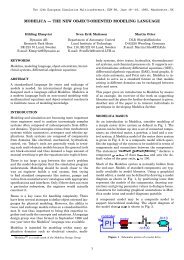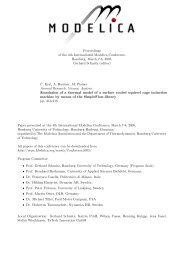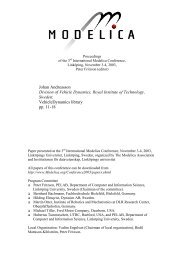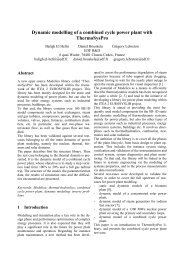Integration of CasADi and JModelica.org - Automatic Control
Integration of CasADi and JModelica.org - Automatic Control
Integration of CasADi and JModelica.org - Automatic Control
You also want an ePaper? Increase the reach of your titles
YUMPU automatically turns print PDFs into web optimized ePapers that Google loves.
Figure 4: Optimization results for the CSTR reactor.<br />
Table 2: Execution times for the CSTR benchmark.<br />
Tool JM <strong>CasADi</strong><br />
coll. coll.<br />
NLP iterations 85 20<br />
Total time 3.2 0.18<br />
Time in NLP solver 1.1 0.16<br />
Time in DAE functions 2.1 0.02<br />
In this example, the Python-based collocation algorithm<br />
is clearly superior, it converges more quickly,<br />
which is likely due to the provided exact Hessian.<br />
Also, the lion’s share <strong>of</strong> the execution time is spent<br />
internally in IPOPT, leaving little opportunities to optimize<br />
the code in function evaluations further.<br />
5.3 Optimal start-up <strong>of</strong> a combined cycle<br />
power plant<br />
5.3.1 Physical model setup<br />
A simplified model <strong>of</strong> a one-level-<strong>of</strong>-pressure<br />
combined-cycle power plant is considered in this<br />
benchmark, see Figure 5 for the object diagram.<br />
The gas turbine model (lower left) generates a prescribed<br />
flow <strong>of</strong> exhaust gas at a prescribed temperature,<br />
which are both a function <strong>of</strong> the load input signal.<br />
The turbine exhaust gases enter the hot side <strong>of</strong><br />
a counter-current heat exchanger, <strong>and</strong> are then discharged<br />
to the atmosphere. The economizer <strong>and</strong> superheater<br />
are modelled by a dynamic energy balance<br />
equation for each side, neglecting compressibility <strong>and</strong><br />
friction effects. The drum boiler evaporator instead<br />
includes both dynamic mass <strong>and</strong> energy balance equations,<br />
assuming thermodynamic equilibrium between<br />
the liquid <strong>and</strong> the vapour phases. The energy storage<br />
Figure 5: Diagram <strong>of</strong> the combined-cycle plant model.<br />
in all the steel walls is accounted for assuming they are<br />
at the same temperature <strong>of</strong> the water/steam fluid.<br />
The feedwater system is described by a prescribed<br />
flow rate source with fixed temperature, driven by a PI<br />
level controller that stabilizes the level dynamics <strong>and</strong><br />
keeps the void fraction in the drum around 0.5.<br />
Finally, the superheated steam enters the steam turbine,<br />
which is modeled as an expansion to the condenser<br />
pressure, assuming a constant isentropic efficiency.<br />
The turbine also exposes a thermal port, corresponding<br />
to the surface where the inlet steam comes<br />
into contact with the turbine rotor. This port is connected<br />
to a thermal model <strong>of</strong> the hollow shaft, given<br />
by Fourier’s heat equation, discretized by the finite difference<br />
method. The thermal stress on the shaft surface,<br />
which is the main limiting factor in the start-up<br />
transients, is proportional to the difference between the<br />
surface <strong>and</strong> the average temperature <strong>of</strong> the shaft.<br />
In order to keep the complexity low, constant specific<br />
heat cp is assumed in the economizers <strong>and</strong> superheaters;<br />
lumped-parameter models are assumed for<br />
the heat exchanger segments, with just one temperature<br />
state for each side. Last, but not least, also the<br />
turbine rotor thermal model has only one temperature<br />
state resulting from the discretization <strong>of</strong> Fourier’s<br />
equation. The resulting nonlinear model has nine state<br />
variables <strong>and</strong> 127 algebraic variables. A more detailed<br />
discussion on the physical modelling <strong>of</strong> the plant can<br />
be found in [11].<br />
5.3.2 Minimum-time start-up<br />
The goal <strong>of</strong> the optimization problem is to reach the<br />
full load level as fast as possible, while limiting the<br />
peak stress value on the rotor surface, which deter-
















